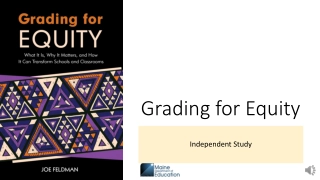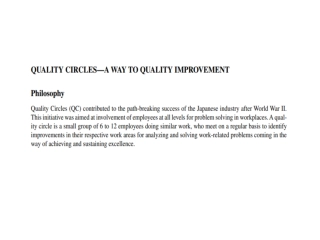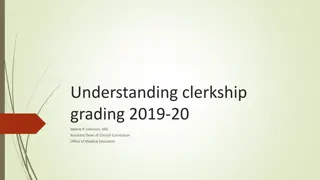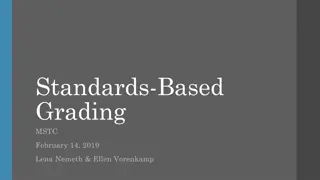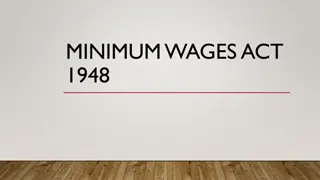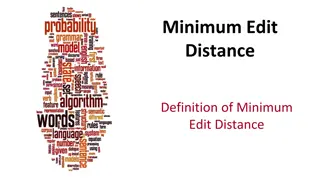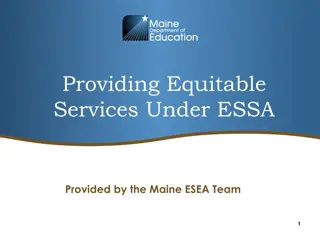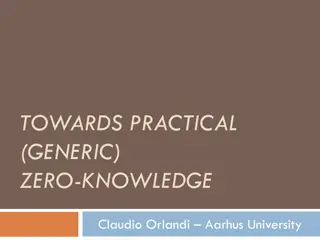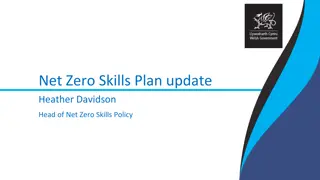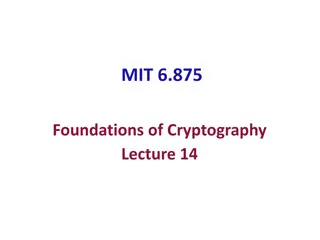Equitable Grading Practices: Pillars, Zero Policies, and Minimum Grading
Explore the three pillars of equitable grading: accuracy, bias-resistance, and motivation. Learn about the impact of giving zeros on student grades and discover alternative approaches. Delve into the concept of minimum grading and how adjusting grading scales can enhance student engagement and success.
Download Presentation

Please find below an Image/Link to download the presentation.
The content on the website is provided AS IS for your information and personal use only. It may not be sold, licensed, or shared on other websites without obtaining consent from the author. Download presentation by click this link. If you encounter any issues during the download, it is possible that the publisher has removed the file from their server.
E N D
Presentation Transcript
DAVID POWERS FALL FLEX DAY OCT. 20, 2020 GRADING FOR GRADING FOR EQUITY EQUITY
GRADINGFOREQUITY.ORG GRADINGFOREQUITY.ORG Free equitable grading resources
The Three Pillars of Equitable Grading The Three Pillars of Equitable Grading Grading must be Accurate Grading must be Bias-Resistant Grading must be Motivational
Pillar 1: Accuracy Pillar 1: Accuracy Our grading must use calculations that are mathematically sound, Our grading must use calculations that are mathematically sound, easy to understand, and correctly describes a student's level of easy to understand, and correctly describes a student's level of academic performance. academic performance.
The Zero The Zero Often a zero is given for major assignments not handed in or assessments not taken. These are critical to determining an accurate grade for students. Unless a student actually knows nothing about the content, they should not get a zero. It is not an accurate representation of their knowledge. Giving a zero on a major assignment will put students into a hole their grade may not be able to recover from. It will often cause students to give up in a class and perhaps school in general.
The Zero The Zero So what can be done if a student does not complete an important assignment or assessment needed to evaluate the student? 1. We can require students complete the assignment. 2. We can exclude the assignment. 3. We can assign a number other than zero.
Minimum Grading Minimum Grading Almost 2/3 of the scale is devoted to one grade, an F. A student who has a 40% in the class has to work twice as hard as student getting a 70% to raise their grade one letter grade. Often this can lead to feelings of hopelessness and students giving up. They feel like they're in a hole they can't dig themselves out of. What could we do to fix this? D D C C B B A A F F Traditional Grading Scale
Minimum Grading Minimum Grading What if our grading scale looked like this? Now every student has to bring their grade up, at most 10%, to raise their grade one letter grade. Students no longer need to feel hopeless or give up. Their grade is not in a deep hole. They are motivated to keep working to improve. B B F F D D C C A A
0 0- -4 Grading Scale 4 Grading Scale Often when grading assignments we use the 0-100 grading scale. This can cause issues. As stated before, almost 2/3 of the scale emphasizes failure. If zeros, are used, it disproportionately punishes students who do not do the work. It is susceptible to error and variance. Is there really a clear difference between a student who earns a 73% and a 74%?
0 0- -4 Grading Scale 4 Grading Scale What if we went to a 0-4 grading scale? Now only 1/5 of the scale represents failing. It is more oriented to student success. It is simpler to use and understand and less prone to error and variance. Teachers who prefer not to use zero, can modify and do a 1-5 grading scale. Score Grade 4 A 3 B 2 C 1 D 0 F
Problems With Averaging Problems With Averaging Suppose a student got the following scores on exams: 91%, 92%, 40%, 94%, 94% Taking the average (mean) of the scores we get (91 + 92 + 40 + 94 + 94)/5 = 82.2% So the student would get a B in the class even though the majority of the time that student did A level work.
Problems With Averaging Problems With Averaging Averaging of any kind applies a mathematical calculation to a set of student scores without regard to when those scores happened. We want to describe a student's overall performance over time.
Consider the following four students: Tanya: She did not really learn how to write a persuassive essay well in high school. She also had challenges at home the first half of the semester. However, now that things have stabilized, she is doing well and earned an A on the final essay. Jason: He attended a different high school and was taught how to write a persuassive essay. He got a B on his first essay and has been honing his skills. He earned an A on the final essay.
Maria: She attended the same high school as Jason and really loves to write. She earned an A on her first essay and has been a strong writer all semester. She earned an A on the final essay. Ellis: He attended the same high school as Tanya. He also never learned how to write a persuassive essay very well. He earned a D on his first essay but with continued practice and feedback, he kept improving. He earned an A on his final essay. What grade should each student earn?
Weighting More Recent Performance Weighting More Recent Performance Instead of averaging performance over time, what if we simply assigned a grade that is the most accurate description of a students' skill level. In this case, at the end of their learning. In most cases, when we measure and describe someone's skill, we use their most recent performance. If a person passes their driving test, we don't average their previous scores. If we need a plumber, we don't ask to see how they performed as an apprentice.
Weighting More Recent Performance Weighting More Recent Performance When we consider scores from earlier in a students' learning process, our grade reflects their learning trajectory and not their achievement. What skills did the student start with? Did they learn quickly or slowly? It should not matter in our grading what pathway a student took to learning. A grade is accurate when it reflects the current level of performance not the history of the performance. It's also equitable. Advantages and disadvantages for a student should not be considered.
Group Grading Group Grading Often we assign group projects. We want students to collaborate. Often a grade is given to the group so everyone is held accountable for doing their part. But that grade does not necessarily reflect each student's contribution, or more importantly, each student's content knowledge. Assigning a single grade to all students in a group actually compromises each student's individual accountability to understand the project's content and yields grades that are invalid and inaccurate. But group work is important, so how can we fix this?
Group Grading Group Grading 1. Clearly explain the purpose of the group project and what student's will be expected to learn. Also that students will have to individually demonstrate that learning on an assessment. 2. Brainstorm with students about best practices for being productive and avoid practices that are unproductive. Maybe help students establish group norms and provide a rubric that reflects expectations. 3. Be patient with students. Many will have little to no experience with group work. Give clear and frequent feedback to the groups. 4. After the group work, assess each student individually to determine whether each learned the content or skills the group work was designed to teach.
Pillar 2: Bias Pillar 2: Bias- -Resistant Grades should be based on valid evidence of a student's content Grades should be based on valid evidence of a student's content knowledge, and not based on evidence that is likely to be knowledge, and not based on evidence that is likely to be corrupted by a teacher's implicit bias or that reflects a student's corrupted by a teacher's implicit bias or that reflects a student's environment. environment. Resistant
Common Teacher Biases Common Teacher Biases Providing extra credit Penalizing for late work Punishing for cheating Evaluating student behaviors Including homework in the grade
Providing Extra Credit Providing Extra Credit 1. Offering extra credit reinforces that class isn't really about learning or mastery of learning outcomes, it's about accumulating points. 2. Even if extra credit points are offered for something related to course content, students learn that weak learning in one content area can be compensated for by more work in another. 3. Extra credit undermines curriculum and instruction. Points can be used to backfill or compensate for material not learned earlier. 4. Extra credit is inequitable because is reflects a student's environment. Does the student have extra time to do the work? Extra money to go a movie/exhibit? Extra support to complete the work? 5. If work is important, require it. If it is not, don't include it in the grade.
Penalizing for Late Work Penalizing for Late Work 1. The Practice is inaccurate. A student who has demonstrated A level work now has their grade lowered. 2. Penalizing disproportionately hurts the most vulnerable students. Students with few resources, weak prior knowledge, overwhelming schedules, a lack of engagement, stress, and simple forgetfulness. 3. Students may learn at a slower rate and simply need more time. 4. Many students may resort to copying to not lose points.
Accepting Late Work Without Penalty Accepting Late Work Without Penalty 1. Grades are a more accurate reflection of student academic performance. 2. Learning becomes more important than deadlines. 3. We send the message that it's better to produce high quality work after the deadline than cut learning short. 4. Students are less likely to copy.
Alternative Consequences for Cheating Alternative Consequences for Cheating Often students caught cheating receive a zero or severe reduction on the test or assignment. We want students to understand this behavior is not tolerated. The problem is we're including student behavior into a grade that is supposed to only represent a student's academic performance. Also giving a zero or other reduced score makes the students grade inaccurate. The score they get is not a true reflection of the students' knowledge. So how do we deal with cheating?
Alternative Consequences for Cheating Alternative Consequences for Cheating We want our punishment to be rehabilitative rather than retributive. Students cheat for a variety of reasons but at its core, they know they will not be successful and don't want to demonstrate their level of knowledge. 1. Rather than evade an assignment or assessment, the student should be required to do the work without cheating so their true level of knowledge can be accurately determined. 2. The student can be required to reflect on their mistake and how their behavior affected others. They might also learn productive behaviors to prevent the same thing happening. 3. The students can be required to apologize as a form of restitution.
Excluding Participation and Effort From the Grade Excluding Participation and Effort From the Grade Often teachers will use effort as a "grade hack". If a student put in a lot of effort but came up a little short of an A, teachers will justify manually adjusting grading software so the student ends up with an A. Participation points do not include valid evidence of a student's content knowledge and therefore have no place in a student's grade. Grading student effort opens the door to bias and subjectivity. There is also no way to grade effort completely since we cannot see student effort outside of our classes. Hard work, perseverance, resilience, grit, etc. are all important for success in school and life but should not be included in a student's grade. The most accurate and non-biased reflection of effort is increased academic performance.
Homework Homework At its core, homework is meant to help students practice what they learned in class and to give the teacher insight into a students' understanding. Grading homework gives an inaccurate representation of student knowledge because students have not yet mastered the content. We enter less-than- perfect scores into the grade book. Other environmental factors may have an effect on a students' ability to complete homework correctly. Grading homework for completion provides a grade "cushion" to many students, adding points that compensate for low summative scores.
Reframing Homework Reframing Homework We want a students' grade to vividly represent what they know. We must not provide or subtract points for homework. For this reason, homework should not be included in the grade. Benefits of omitting homework include: Students have no incentive to copy. Teachers can reallocate their time. Students learn to take responsibility for their own learning. We no longer "double-punish" students for missing problems on homework and tests. We allow for different learning styles. We don't penalize students for environmental factors. Our feedback is heard and valued. Students tend to tune out once a grade is assigned.
Basing Grades Entirely on Summative Assessments Basing Grades Entirely on Summative Assessments Eliminating any grading related to student behavior lateness, participation, or effort- also eliminates bias and subjectivity. Eliminating formative assessments such as homework and in-class assignments means we are not including mistakes students make while learning. Summative assessments are designed to accurately measure what students know at the end of the learning process. So if we only include summative assessments (1) How would this affect how teachers approach assessments? (2) How do we prevent this emphasis on summative assessments from creating more stress for students and punishing students who don't test well?
(1) How does this affect how teachers approach (1) How does this affect how teachers approach assessments? assessments? We need to become open and obligated to consider how we can expand assessment strategies so that students have a full opportunity to demonstrate what they know. We need to allow and invite students to portray their knowledge visually, linguistically, and even verbally to ensure that we accurately access a student's content understanding. This will allow us to apply our professional judgement to every assessment result, ensuring that every score we incorporate is an accurate reflection of what the student is learning.
(2) (2) How do we prevent How do we prevent this assessments assessments from creating more stress for from creating more stress for students students and and punishing students who punishing students who don't well? well? Equitable grading marries the emphasis of summative assessments with offering retake opportunities. Offering retakes on summative assessments make a student less anxious if they know they can make a mistake on a summative assessment and still have another chance to demonstrate their understanding. this emphasis emphasis on summative on summative don't test test
Pillar 3: Motivation Pillar 3: Motivation The way we grade should motivate students to achieve academic The way we grade should motivate students to achieve academic success, support a growth mindset, and give students success, support a growth mindset, and give students opportunities for redemption. opportunities for redemption.
Motivation Motivation We do not want students to be extrinsically motivated. Do this assignment and you'll get that grade. Aiming for high grades is not a bad thing but F's often do not motivate students to work harder. They often cause our most underserved populations to give up. We want our students to be intrinsically motivated. Do this because you want to learn. We want students to have a growth mindset. Extrinsic rewards undermine intrinsic motivation.
Retakes Retakes When a student performs poorly on an assessment, there are likely three causes: An event or condition impeded a student from performing their best. The format or design of the assessment impeded the student from communicating their knowledge. The student inadequately prepared or had weak understanding. What score would qualify a student for a retake?
Retakes Retakes Every student should have the chance to continue learning from their mistakes and to show improved understanding. Retakes should be open to all but should be mandatory for students who earn a D or F. Often higher performing students will voluntarily do retakes but lower performing students will avoid retakes to avoid a possible second failure. Retakes should be confined to summative assessments. Retaking formative assessments could be done but would likely be very tedious. If a student does a retake, they should be limited to only the material they have not yet demonstrated mastery on. A second or more retakes are allowed if necessary.
Retakes Retakes Between the original assessment and retake, the student needs to demonstrate growth of learning. This can take many forms: 1. Attend tutoring sessions or office hours. 2. Assigning extra work targeting the particular gaps. 3. Redoing any classwork or homework assignment about topics or skills the student has not mastered. 4. Any other way the student can demonstrate they have made sufficient improvement and will perform better on the retake.
Practices That "Lift the Veil" Practices That "Lift the Veil"
Rubrics Rubrics Rubrics equip students to self-assess and even peer-assess work, empowering them not only to know exactly what grade they will get, but exactly what to improve in order to earn a higher grade. Rubrics make grading more straightforward and bias-resistant, relieving the teacher of the worry that student evaluation of work won't be objective. Rubrics also help teachers make sure that our evaluations are consistent. Rubrics require us to identify and articulate how student work will be graded, as well as the different gradations of quality that will earn each grade , with the goal that anyone who uses the rubric will make a similar judgement about the work.
Example Example 1 2 3 4 Passing Student does not attempt to pass the ball to a teammate during a game of basketball. Student is able to pass the ball but not yet with accuracy. The teammate has to move more than 5 feet to receive the pass. Student is able to pass the basketball accurately to a teammate in a game of basketball. Student is able to pass the ball accurately between two defenders. Dribbling Student does not dribble the ball and constantly walks or runs with the ball in hand. Student dribbles the ball at times with two hands. Student is able to dribble the ball with one hand at a time. Student is able to cross over a defender and break ankles. Shooting Student does not attempt to shoot the ball at all during a basketball game. Student executes some of the letters of BEEF on shots taken during a basketball game. Student is able to execute all of the letters of BEEF consistently during shots. Student is able to execute all of the letters of BEEF consistently during shots and is able to make all or most shots. BEEF: Balance, Eyes (on target), Elbow in correct position, and Follow-Through
Rubrics Rubrics A common mistake teachers make is to introduce the 0-100 percent scale. For example, suppose meeting the measurable objective in the basketball rubric is a score of 3. Now suppose a student scored a 2 in each of the three categories meaning they earned 6 points total. Since the maximum score in each category is 4 (12 total), a student would receive 6/12 = 50% = F, even though the student almost met every measurable objective. Even if the student did meet the measurable objective in one category, they would still earn 3 + 2 + 2 = 7/12 = 58% which is still an F.
Alternatives Alternatives 1. Use the mean (average), mode (most frequent), or median (middle number) of the scores to define the student's performance on the rubric. Then convert that number to a letter grade. 2. Record the score from each category in the grade book to be used later if multiple measurable objectives are assessed by the rubric. 3. Decide the value of each criterion and weight each appropriately. Is each relatively equal or are some more important than others? For example, the basketball teacher may decide dribbling is the most important skill and no matter how well a student shoots or passes, their dribbling must be high quality to earn a high grade.
Empowering Students Empowering Students Rubrics can be tough for students to understand. Some tips for helping them. 1. Focus students on a single criterion rather than all of them at once, then add criteria as students become familiar with the task and how to apply the rubric. 2. Ask students to translate the rubric into student-friendly language to identify what distinguishes each level of performance within a criterion. 3. Have students find specific connections between the instructions for a project and its rubric to help students recognize the relationship between both.
Standards Standards- -Based Grade Books Based Grade Books Typical gradebooks list every assignment and assessment chronologically, each with points earned out of total points, tied to a weighted category. Gradebooks designed to reflect student performance on specific measurable objectives (standards) are much simpler, and therefore more organized, transparent, and comprehensible
Example Example Semester Measurable Objectives Assignments Assignment 1 8/24/20 4pts Assignment 2 8/31/20 4pts Assignment 3 9/9/20 4pts Student Grade Objective 1 8/17/20 4pts Objective 2 8/17/20 4pts Objective 3 8/17/20 4pts Objective 4 8/17/20 4pts Student 1 B- 2.5 3 3 2 2 2 2.5 Student 2 B 3.5 3 3 2 0 0 3.5 Student 3 C+ 2 3 2.5 1.5 3 4 2 Student 4 C- 1 1 2 1 0 0 1 Student 5 C 2 2 1 2 3 2 2 Student 6 C 2 1.5 2.5 2.5 3 2 2 Student 7 C- 2 2 1 1 0 0 2 Student 8 C+ 3 2.5 1 1 3 3 3
Standards Standards- -Based Grade Books Based Grade Books A standards based grade book does not rely on computer software to determine a students' grade. Teachers are allowed to use their professional judgement and the evidence available to determine a students' grade. Gradebooks become much simpler for teachers to work with and students to understand. There is much more transparency. Teachers can quickly identify which measurable objectives (standards) a student has not yet mastered and how best to support them (extra practice, reteach the concept, etc.)
Summary of Strategies Summary of Strategies Avoiding Zeros Grades Based on the Work, Not the Timing of the Work Minimum Grading Alternative Consequences for Cheating 0-4 Scale Weighting More Recent Achievement Excluding Participation and Effort Grades Based on Summative and Not Formative Assessments Grades Based on Individual Achievement, Not the Group's Retakes Grades Based on Required Content, Not Extra Credit Rubrics Standards-Based Gradebooks
Recent News Recent News https://www.nbcsandiego.com/news/local/san-diego-unified-school-district-changes-grading-system-to-combat-racism/2425346/
Thank You for Coming! Thank You for Coming! HTTPS://FORMS.GLE/XBCD6UO3QEDU3GQ48


